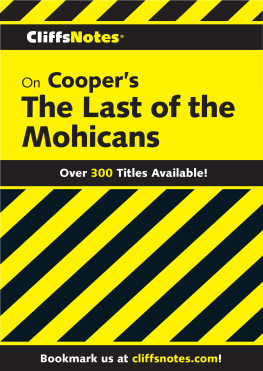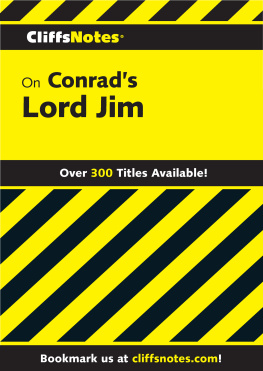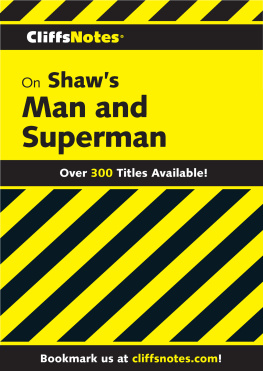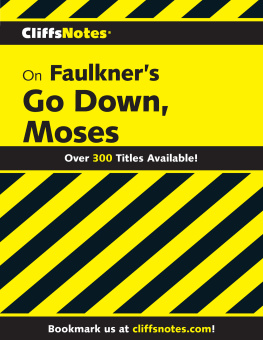Thomas J Roundtree - CliffsNotes on Coopers The Last of the Mohicans
Here you can read online Thomas J Roundtree - CliffsNotes on Coopers The Last of the Mohicans full text of the book (entire story) in english for free. Download pdf and epub, get meaning, cover and reviews about this ebook. year: 2007, publisher: HMH Books, genre: Home and family. Description of the work, (preface) as well as reviews are available. Best literature library LitArk.com created for fans of good reading and offers a wide selection of genres:
Romance novel
Science fiction
Adventure
Detective
Science
History
Home and family
Prose
Art
Politics
Computer
Non-fiction
Religion
Business
Children
Humor
Choose a favorite category and find really read worthwhile books. Enjoy immersion in the world of imagination, feel the emotions of the characters or learn something new for yourself, make an fascinating discovery.
- Book:CliffsNotes on Coopers The Last of the Mohicans
- Author:
- Publisher:HMH Books
- Genre:
- Year:2007
- Rating:5 / 5
- Favourites:Add to favourites
- Your mark:
- 100
- 1
- 2
- 3
- 4
- 5
CliffsNotes on Coopers The Last of the Mohicans: summary, description and annotation
We offer to read an annotation, description, summary or preface (depends on what the author of the book "CliffsNotes on Coopers The Last of the Mohicans" wrote himself). If you haven't found the necessary information about the book — write in the comments, we will try to find it.
This CliffsNotes guide includes everything youve come to expect from the trusted experts at CliffsNotes, including analysis of the most widely read literary works.
CliffsNotes on Coopers The Last of the Mohicans — read online for free the complete book (whole text) full work
Below is the text of the book, divided by pages. System saving the place of the last page read, allows you to conveniently read the book "CliffsNotes on Coopers The Last of the Mohicans" online for free, without having to search again every time where you left off. Put a bookmark, and you can go to the page where you finished reading at any time.
Font size:
Interval:
Bookmark:
Copyright 1965 Houghton Mifflin Harcourt Publishing Company
All rights reserved.
www.hmhco.com
cliffsnotes.com
For information about permission to reproduce selections from this book, write to or to Permissions, Houghton Mifflin Harcourt Publishing Company, 3 Park Avenue, 19th Floor, New York, New York 10016.
The publisher and the author make no representations or warranties with respect to the accuracy or completeness of the contents of this work and specifically disclaim all warranties, including without limitation warranties of fitness for a particular purpose. No warranty may be created or extended by sales or promotional materials. The advice and strategies contained herein may not be suitable for every situation. This work is sold with the understanding that the publisher is not engaged in rendering legal, accounting, or other professional services. If professional assistance is required, the services of a competent professional person should be sought. Neither the publisher nor the author shall be liable for damages arising herefrom. The fact that an organization or website is referred to in this work as a citation and/or a potential source of further information does not mean that the author or the publisher endorses the information the organization or website may provide or recommendations it may make. Further, readers should be aware that Internet websites listed in this work may have changed or disappeared between when this work was written and when it is read.
Trademarks: CliffsNotes, the CliffsNotes logo, Cliffs, cliffsnotes.com, and all related trademarks, logos, and trade dress are trademarks or registered trademarks of Houghton Mifflin Harcourt Publishing Company. All other trademarks are the property of their respective owners. Houghton Mifflin Harcourt is not associated with any product or vendor mentioned in this book.
eISBN 978-0-544-18249-3
v1.0517
Guided by the displaced Huron warrior Magua, four peopleMajor Duncan Heyward, Psalmodist David Gamut, and Alice and Cora Munrostrike through the wilderness forest for Fort William Henry, which is besieged by the French near Lake George. Led astray by Magua, they encounter the white woodsman Hawkeye and his two Mohican companions, Chingachgook and Uncas, whereupon the villainous Huron escapes.
Traveling to the safety of the caves at Glenns Falls, the party is attacked by Indians early the next morning. Running out of munitions, the three woodsmen escape downriver for help, but the others are captured and taken away by a splinter group of warriors headed by Magua. After a long journey, the Huron coldly proposes to Cora, whose refusal brings an attack upon the captives, who are saved by the sudden arrival of the three woodsmen. All the Indians are killed except Magua, who gets away again.
Leading the party of protagonists through narrow escapes from Indians and then besieging Frenchmen, Hawkeye brings them to a mountainside vantage point overlooking the fort. During the trip, a quiet interest develops between the young Uncas and the brunette Cora, while Heyward shows a deference toward Alice. With difficulty finding their way through the heavy morning mists and the omnipresent French, the seven, hotly pursued, finally reach the fort, where Commander Munro recognizes the voice of his daughter Alice and opens a sally-port for them. Heyward leads a repulse of the pursuing Frenchmen.
With the passage of days, a parley is held, and, since General Webb is sending no help, Munro agrees to surrender. Meanwhile, Heyward learns that Coras darkened aspect lies not only in a brooding nature but also in the fact that she is part black. During the planned withdrawal of the English forces, the Indians begin a bloody massacre, and Magua once again escapes with the two girls and Gamut.
Three days later, the three woodsmen, Munro, and Heyward go north of the lake and across the country in pursuit. When Uncas is captured by the Hurons, Hawkeye effects his escape and Alices through disguise and all head for the Delaware village where Cora is held captive. Magua follows and demands his prisoners. Uncas reveals himself as a chief to the patriarch Tamenund, and Magua is allowed his only rightful prisoner, Cora, though the protagonists and the Delawares vow to follow and regain her freedom. Coming out of hiding in a beaver pond, Chingachgook and Munro join the ensuing battle, in which the Hurons are defeated. Nonetheless, Magua and two warriors escape with Cora through the nearby caves and up a mountainside. Finally cornered by Hawkeye, Heyward, Gamut, and Uncas, the Hurons give defiance and in the fighting Cora, Uncas, and Magua are killed.
The next day is one of mourning for the Delawares. Cora and Uncas are buried side by side, and all the white characters except Hawkeye leave. When Chingachgook states that he is now alone, Hawkeye grasps his hand and declares that such is not so. At the same time, Tamenund sadly comments upon the worsening historic plight of the American Indians and particularly upon the tragically accomplished demise of the wise and noble race of Mohicans.
Todays reader, geared to a modern tempo and coming again or coming fresh upon Coopers The Last of the Mohicans, may wonder what all the acclaim was and is about. For Cooper was a popular and financial success here in America, while his acknowledged eminence abroad led, long before his death, to translations in all the languages of Western Europe, plus those of Persia, Egypt, and Turkey. Hence, like Dickens later, Coopers work was often as popular overseas as at home. In 1828, for instance, the composer Franz Schubert, lying near death in Vienna, asked a friend to rush him Coopers latest book in print; and nearly a century later, when in 1917 the United States entered World War I on the side of France, a Frenchman toasted his surprised American listeners by calling out, The spirit of Leather-Stocking is awake! Thus among the nicknames for Natty Bumppo (Deerslayer, Hawkeye, Pathfinder, Leather-Stocking, the trapper), Leather-Stocking became the common one attached to the character and to the series of five novels.
To appreciate the novel properly, the reader needs to remember something of the method of publication in Coopers day. Like his other novels, The Last of the Mohicans was published in two volumes, a predetermined circumstance that partly accounts for the major division of the novel into two long chase sequences with a short intermediate stay of relative safety for the main characters at Fort William Henry. Herein is the big pattern of the book, based upon the suspenseful technique that Cooper made famous in novel after novel: pursuit-capture-escape-and-pursuit. The demands of publication, then, as well as the nature of his subject matter and his own propensities as a writer, are operative in this classic of patterned adventure.
Similarly, publishers deadlines, readers with the leisure and desire for long contact with fictional characters and situations, the rapid writing pace that Cooper set himself, and his honesty in doing what he did bestall were instrumental in evolving the amazing improvisation in this and other novels by Cooper. Here he stays within the confines of frontier adventure and within the form and structure of the novel. But in his professional field, Cooper is as inventive as twentieth-century jazz and modern ballet; and the present-day reader should need only to shift tolerance from one subject and form to another in order to appreciateand probably enjoythis early American classic that explores one of our greatest traditions and first bodies forth at its best what is doubtless the American myth.
In The Last of the Mohicans, the frontier is both a place and a condition made up of opposite, usually conflicting forces, for the very nature of a frontier is that it is the demarcating area where things come together with all their differences. In the pervading historical background of the novel is the conflict between civilization and so-called savagism: the wresting of a continent from nature and the Indians. More immediate is the clash between the French and the English for colonial control of the land (the time of the novel is the summer of 1757); and for mercenary help these two nationalities make impermanent, weathercock alliances with already hostile Indians whom Cooper presents as the bad Iroquois stock and the good Delawares and Mohicans of Algonquin stock. The historical confrontation of races is brought into fictional focus with the skirmishes and occasional understandings between individuals and groups of reds and whites, both of whom are in turn at odds with peoples of their own color. One symbolic result is the death of the last offspring of the admirable Mohicans. But what T. S. Eliot would call the objective correlative of this problem is also presented dramatically in terms of miscegenation: the tragic mutual love of the noble Indian Uncas and the sentimentalized yet nonetheless worthy Cora Munro, who is also desired by the villain Magua. In the novel, this thematic problem is slow in developmentwe are, in fact, hardly aware of it until mid-pointand even as it comes into the forefront of action toward the end, it is muted by Cooper at the very time that it becomes the most immediate motivation for the hair-raising events that bring the novel to its close. Without doubt, the novel throughout is one of the bloodiest in American literature, and that tragic bloodshed stems from the fact that, in general historic background and dramatic fictional foreground, human beings are involved in a concept of progress that irresistibly pushes the frontier westward.
Next pageFont size:
Interval:
Bookmark:
Similar books «CliffsNotes on Coopers The Last of the Mohicans»
Look at similar books to CliffsNotes on Coopers The Last of the Mohicans. We have selected literature similar in name and meaning in the hope of providing readers with more options to find new, interesting, not yet read works.
Discussion, reviews of the book CliffsNotes on Coopers The Last of the Mohicans and just readers' own opinions. Leave your comments, write what you think about the work, its meaning or the main characters. Specify what exactly you liked and what you didn't like, and why you think so.













